Assessing your horse’s body condition score

Written by Rebecca Watson
‘Condition’ is a term used to describe muscle development but unfortunately, many people get confused about the difference between good muscle tone and fat. Muscle develops as a result of work, and fat develops due to excessive calorie intake. We cannot change fat into muscle as they are completely different tissues. By exercising, a horse will burn fat and build muscle and this is why some people mistakenly believe that fat can be turned into muscle. Remember calories are energy and energy is calories. If you feed your slightly overweight, laid-back horse more calories than he requires, it won’t give him any more energy, in fact it will result in him gaining even more weight as fat and probably make him even more lethargic.
Examining your horse’s body condition can be quite subjective; your idea of ‘thin or fat’ may be quite different to someone else’s. For this reason a system known as body condition scoring, sometimes referred to as ‘fat scoring’, has been developed. This provides us with a simple, repeatable and consistent way of monitoring the amount of fat a horse is carrying and helps us to differentiate between muscle development and fat accumulation.
When evaluating your horse’s body condition score, remember to feel your horse’s body, get hands on! Looks can be misleading – thick, woolly winter coats or heavy rugs can often hide weight loss, and you don’t want to be surprised when your horse sheds its winter coat in the spring. Interestingly, 60% of people’s visual assessment of their horse’s body condition score is different to their ‘hands on’ score. For owners, who see their horses regularly, it’s not always easy to notice slight changes in body condition. However, body condition scoring your horse every 2 weeks and keeping a record of the results can help you to track any changes and, if needed, adjust your horse’s diet.
There are two systems of body condition scoring but the one most commonly used in the UK and Ireland is the 0-5 system. This system grades the amount of fat cover on the following 3 areas of the horse’s body;
Section 1. Neck and Shoulder (everything in front of the shoulder blade)
- With your thumb and first finger feel along the top of your horse’s neck for the nuchal ligament. There is no muscle above the nuchal ligament so anything above it is fat, not top line. Another sign of fat accumulation in this area is the ‘wobble’ test (i.e. can the crest be bent from side to side). However, be aware that very large crests can often become hard and inflexible.
- Run your hand along your horse’s neck and down towards the shoulder blade, pinch the flesh around his shoulder. If your hand runs smoothly from your horse’s neck to shoulder, it usually means fat has built up in front of the shoulder blades. There should be a natural ‘stop’ for your hand at the shoulder blade.
Section 2. Middle (behind the shoulder blade to the hips and the back)
- Run your hand diagonally across your horse’s rib cage and using firm pressure (not hard pressure) you should be able to feel the ribs easily.
- Place your hand at the bottom of your horse’s withers and feel along your horse’s top line. Your hand should naturally arch over the spine, however if fat has built up on either side of the spine your hand will start to flatten.
Section 3. Bottom (hips, pelvis and hindquarters)
- Standing behind your horse (safely!) place your hand flat on the top of the hindquarters to feel for the top of his pelvis.
- Run your hand from the hindquarters onto the tail, feeling for the tail bone and any fat pads.
- Find the ‘hips’ and curve your hand around, ideally you should be able to feel the outline of the bones.
Given each area a separate score out of 0 (emaciated) to 5 (obese), half points can also be awarded to provide increased accuracy. The average score from all 3 section give you an overall body condition score. However if one area is considerably different to another it is important to note this as it may indicate a potential concern. For example, a cresty neck is often associated with an increased risk of insulin resistance and laminitis. Ideally, your horse should have a BCS of between 2-3 out of five depending on their level of fitness.
Body Condition Scoring and differentiating between fat and muscle can take a little practise, so download our detailed Body Condition Score Guide and try to BCS as many different horses as you can!
Body Condition Scoring Guide
0 – Very Poor/Emaciated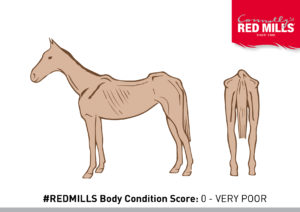
- Neck – marked ‘ewe’ neck, narrow and slack base.
- Back & Ribs – skin tight over the ribs, ribs very clearly visible and back bone sharp and easily seen.
- Pelvis – angular pelvis, skin tight, very sunken rump. Deep cavity under the tail and either side of the croup.
1 – Poor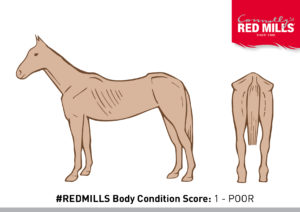
- Neck – ‘ewe’ neck, narrow and slack at the base.
- Back & Ribs – Ribs easily visible, skin sunken, either side of the backbone. Back bone well defined.
- Pelvis – Rump sunken but skin supply, pelvis and croup prominent, cavity under tail.
2 – Moderate 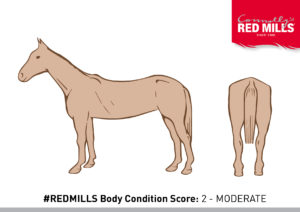
- Neck – narrow but firm, shoulder blade clearly defined.
- Back & Ribs – ribs just visible, backbone well covered. Backbone felt but not seen.
- Pelvis – rump flat either side of the back bone, croup well defined, some fat, slight cavity under the tail.
3 – Good 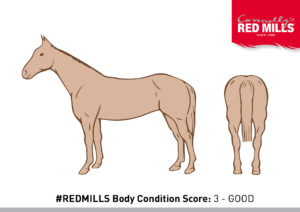
- Neck – firm, no crest (except stallions), shoulder blades defined.
- Back & Ribs – ribs just covered, easily felt. No gutter along the back. Backbone covered, but easily felt.
- Pelvis – covered by fat and rounded, no gutter, pelvis easily felt.
4 – Fat 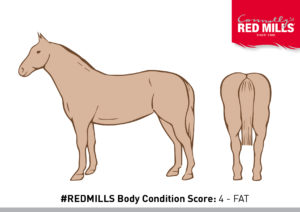
- Neck – slight crest, wide and firm.
- Back & Ribs – Ribs well covered, gutter along backbone.
- Pelvis – pelvis covered, felt with only with firm pressure. Slight ‘apple bottom’ appearance when stand behind the horse.
5 –Very Fat 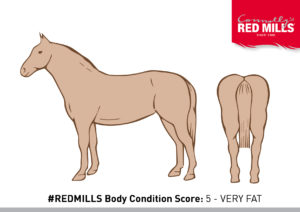
- Neck – marked crest, very wide & firm, folds of fat.
- Back & Ribs – ribs buried and cannot be felt. Deep guttering along back, back broad and flat.
- Pelvis – deep gutter to root of tail, pronounced ‘apply bottom’ appearance, skin distended, pelvis buried, cannot feel.
Download our Body Condition Score factsheet here



